Measures of San Antonio’s Social Capital—Levels of Participation
By Darla Norton, Research Associate, Arturo Vega, Ph.D., Associate Professor, and Juanita M. Firestone, Ph.D., Professor
Issue:
This issue brief is the third of a series of analyses that focus on social capital in Bexar County (San Antonio), Texas. This brief examines the element of participation at the community level. If social capital in a community is high, one might expect that civic participation will also be high. The questions examined here are: What are the levels of participation in San Antonio, Texas? And, are there significant variations in levels of participation among key demographic groups that make up the community?
Data and Methods:
Data for this study were collected during the San Antonio Survey 2003 (SAS 2003), which was conducted during the weeks of October 12-28th, 2003.[i] Responses are from a random probability sample of the general population of adults 18 years of age and older in Bexar County, (San Antonio) Texas, with listed phone numbers. A split sample design produced 423 responses from a random sample of individuals within the county, and an additional oversample of 136 respondents living on San Antonio’s West Side for a total of 559 respondents.[ii] To measure levels of participation, three questions were asked: “Are you registered to vote?” “How frequently have you volunteered?” and “How often do you attend religious services?”[iii]
Findings:
In response to whether “they are a registered voter” over eight in ten (83%) of SAS respondents reported they were registered to vote (see Figure 1). When asked “how frequently have you volunteered?” over half of the respondents reported volunteering “frequently” (28.5%) or “sometimes” (25.3%), while almost three in ten respondents (28.7%) reported they “never volunteer” and just over seventeen percent (17.4%) reported they “seldom” volunteer (see Figure 2).
In response to “how often do you attend religious services?,” almost half of the respondent’s reported attending religious services “weekly” (49.8%), and just over thirteen percent (13.4) reported attending religious services “monthly”. Just over twenty percent (20.2) attend religious services “a few times a year,” while less than six percent “only attend on holidays” (4.3) or “never attend” religious services (1.3) (see Figure 3).
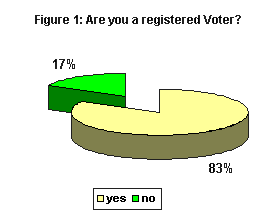 |
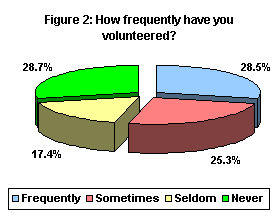 |
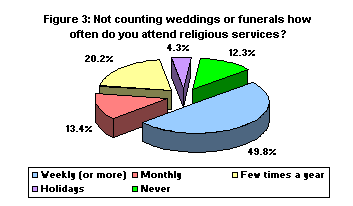 |
Table 1 presents distributions on ‘voter registration’ question by demographic groupings. Here, responses were statistically significant and moderately associated with age, income, race/ethnicity, educational attainment and west side, while living inside or outside the loop was only weakly associated. Fewer than seven in ten (67.3%) young adults (18-29) report that they are registered to vote, while over nine in ten (92.9%) of senior adults (65+) report the same. Voter registration also rises as income increases with almost nine in ten (90.7%) of respondents in the highest income group indicating that they registered to vote, compared to the eight in ten (79.5%) in the lowest income group. Respondents without a high school diploma had the lowest percentage of reported registered voters at just over sixty-one (61.3) percent while nearly all (96%) of the respondents with bachelor’s degrees were identified themselves as registered voters.
Anglo respondents had the highest levels of reported voter registration with over nine in ten (92.2%) registered to vote while African Americans and Hispanics had significantly lower levels of declared registered voters (83.8% and 76.9%, respectively). Respondents living inside the loop were slightly less likely to be registered voters compared to respondents living outside the loop (78.7% vs. 86.3%). Additionally, respondents living on the West side were also less likely to be registered to vote compared to others in Bexar County (75.2% vs. 86.2%, respectively). Finally, there was no statistically significant difference between males and females in the reported rates of voter registration.
Table 2 presents distributions on the ‘volunteering’ question by demographic groupings. Responses were only statistically significant and weak for income level, educational attainment and West side. Over six in ten respondents in the highest income group, for example, report volunteering compared to less than half of the respondents in the lowest income groups. Fewer than half of the respondents with less than a high school education (38.7%) or a high school education (48%) reported that they volunteer, while nearly six in ten of respondents with some college (60.4%) or a bachelor’s degree (58.4%) report that they volunteer. Respondents with a graduate degree had the highest levels of volunteering with seven in ten reporting they (70.5%) volunteer regularly. Fifty-six (56.2) percent of the respondents in Bexar County reported they volunteer (56.2%), while less than half (44.7%) of the respondents living on the West Side rport that they volunteer.
Table 1: Voter Registration by Demographic Determinants
| No | Yes | Chi.Sq. | Sig | Cramers V | Gamma | |
| AGE | ||||||
| 18-29 | 32.7% | 67.3% | 34.78 | 0.01 | 0.26 | 0.46 |
| 30-39 | 23.0% | 77.0% | ||||
| 40-49 | 18.8% | 81.3% | ||||
| 50-64 | 7.9% | 92.1% | ||||
| 65+ | 7.1% | 92.9% | ||||
| INCOME | ||||||
| $0-29,999k | 20.5% | 79.5% | 6.59 | 0.05 | 0.13 | 0.30 |
| $30-59,999k | 13.3% | 86.7% | ||||
| $60,000k + | 9.3% | 90.7% | ||||
| LOOP | ||||||
| Inside | 21.3% | 78.7% | 4.96 | 0.05 | 0.10 | 0.26 |
| Outside | 13.7% | 86.3% | ||||
| RACETH | ||||||
| White | 7.8% | 92.2% | 19.89 | 0.01 | 0.20 | |
| Hispanic | 23.1% | 76.9% | ||||
| Black | 16.2% | 83.8% | ||||
| DEGREE | ||||||
| <Hs | 38.7% | 61.3% | 39.93 | 0.01 | 0.28 | 0.46 |
| High School | 18.2% | 81.8% | ||||
| Some Coll | 13.0% | 87.0% | ||||
| Bachelors | 4.0% | 96.0% | ||||
| Graduate | 11.5% | 88.5% | ||||
| GENDER | ||||||
| Male | 15.5% | 84.5% | 0.66 | n/s | 0.04 | -0.09 |
| Female | 18.2% | 81.8% | ||||
| WESTSIDE | ||||||
| Westside | 24.8% | 75.2% | 9.47 | 0.05 | 0.13 | -0.35 |
| Bexar | 13.8% | 86.2% |
Table 3 presents the distributions to the ‘religious attendance’ question by demographic groupings. Age was the only factor that was statistically significant but weak relationship with the question. Here, about four in ten respondents under the age of forty, for example, report attending religious services “frequently;” in contrast, over half of the respondents forty and older report attending religious service “frequently.”
Finally, Figures 4 thru 6 display the three dimensions of participation (voter, volunteer, and religious) by race/ethnicity, controlling for geographic location. Figure 4, for example, shows that Westsiders and Hispanics have lower levels of voter registration than Anglos in Bexar County. Anglo respondents living in Bexar County are nearly ten percent more likely to report to be registered to vote compared to Anglos on the West Side. In addition, Anglos in Bexar County are significantly more likely to be registered to vote than Hispanics on the West Side or in the rest of Bexar County. In addition, Westsiders have lower levels of volunteering compared to others in Bexar County (see Figure 5). Moreover, Hispanics not living on the West Side are more likely to volunteer compared to Hispanics living on the West Side (54.3% vs. 46.1%). Anglos not living on the West side were even more likely to volunteer compared to their counterparts on the West side (55.1% vs. 36.4%). However, Westsiders had slightly higher levels of religious attendance, in particular Anglos living on the West Side were significantly more likely to attend religious services frequently compared to others in Bexar County (58.3% vs. 44.6%). There was very little variation between Hispanics (see Figure 6).
Table 2: Volunteering by Demographic Determinants
| Seldom | Frequently | Chi.Sq. | Sig | Cramers V | Gamma | |
| AGE | ||||||
| 18-29 | 45.5% | 54.5% | 3.06 | n/s | 0.08 | -0.08 |
| 30-39 | 40.2% | 59.8% | ||||
| 40-49 | 50.0% | 50.0% | ||||
| 50-64 | 47.6% | 52.4% | ||||
| 65+ | 51.8% | 48.2% | ||||
| INCOME | ||||||
| $0-29,999k | 56.6% | 43.4% | 12.46 | 0.01 | 0.18 | 0.28 |
| $30-59,999k | 50.4% | 49.6% | ||||
| $60,000k + | 34.6% | 65.4% | ||||
| LOOP | ||||||
| Inside | 42.7% | 57.3% | 1.96 | n/s | 0.06 | -0.13 |
| Outside | 49.1% | 50.9% | ||||
| RACETH | ||||||
| White | 45.9% | 54.1% | 3.99 | n/s | 0.09 | |
| Hispanic | 49.6% | 50.4% | ||||
| Black | 32.4% | 67.6% | ||||
| DEGREE | ||||||
| <Hs | 61.3% | 38.7% | 19.05 | 0.01 | 0.19 | 0.26 |
| High School | 52.0% | 48.0% | ||||
| Some Coll | 39.6% | 60.4% | ||||
| Bachelors | 41.6% | 58.4% | ||||
| Graduate | 29.5% | 70.5% | ||||
| GENDER | ||||||
| Male | 49.8% | 50.2% | 1.50 | n/s | 0.05 | 0.11 |
| Female | 44.5% | 55.5% | ||||
| WESTSIDE | ||||||
| Westside | 55.3% | 44.7% | 5.77 | 0.01 | 0.1 | -0.23 |
| Bexar | 43.8% | 56.2% |
Discussion:
Voter registration, volunteering and religious attendance are important indicators of social capital, especially at the community level. The extent to which individuals feel integrated into the community increases the likelihood they will participate in public or civic engagements such as voting and volunteering. Furthermore, volunteering in non-political civic events entails no economic benefit for the individual, which means there is a level of self-sacrifice or interest in helping the community on the part of those who participate in civic affairs (Baum and Ziersch, 2003)[iv]. Participation is also essential to acquiring access to additional social capital elements such as developing social networks and increased levels of social trust.
Table 3: Religious Attendance by Demographic Determinants
| Not Relig | Religious | Chi.Sq. | Sig | Cramers V | Gamma | |
| AGE | ||||||
| 18-29 | 61.6% | 38.4% | 10.58 | 0.05 | 0.14 | 0.16 |
| 30-39 | 60.5% | 39.5% | ||||
| 40-49 | 44.3% | 55.7% | ||||
| 50-64 | 49.6% | 50.4% | ||||
| 65+ | 45.5% | 54.5% | ||||
| INCOME | ||||||
| $0-29,999k | 58.0% | 42.0% | 0.62 | n/s | 0.04 | 0.07 |
| $30-59,999k | 54.8% | 45.2% | ||||
| $60,000k + | 53.3% | 46.7% | ||||
| LOOP | ||||||
| Inside | 50.0% | 50.0% | 0.24 | n/s | 0.02 | -0.05 |
| Outside | 52.3% | 47.7% | ||||
| RACETH | ||||||
| White | 54.6% | 45.4% | 1.82 | n/s | 0.06 | |
| Hispanic | 48.5% | 51.5% | ||||
| Black | 48.6% | 51.4% | ||||
| DEGREE | ||||||
| <Hs | 47.3% | 52.7% | 3.12 | n/s | 0.08 | 0.00 |
| High School | 53.4% | 46.6% | ||||
| Some Coll | 45.5% | 54.5% | ||||
| Bachelors | 55.4% | 44.6% | ||||
| Graduate | 47.5% | 52.5% | ||||
| GENDER | ||||||
| Male | 55.6% | 44.4% | 3.44 | n/s | 0.08 | 0.16 |
| Female | 47.5% | 52.5% | ||||
| WESTSIDE | ||||||
| Westside | 46.7% | 53.3% | 1.73 | n/s | 0.06 | 0.18 |
| Bexar | 53.0% | 47.0% |
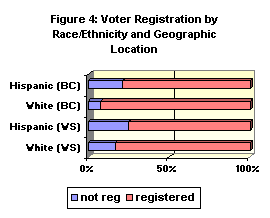 |
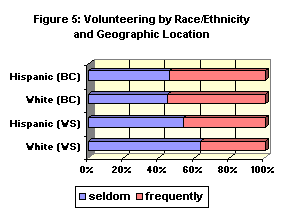 |
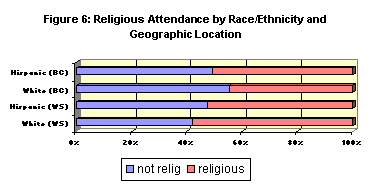 |
Our survey findings offer mixed results on the three dimensions of participation. Young, low income, less educated, African American and Hispanic and Westside San Antonians, for example, lag behind their counterparts in reported registration rates, while income, educational attainment and geographic residence in the Westside impact volunteering. And, while westsiders are less likely to be registered to vote or volunteer, they are more likely to attend religious services frequently. Finally, while each of the demographic determinants (with the exception of gender) was a significant predictor of voter registration, only age was a significant predictors of religious attendance.
Notes
[i] The SAS 2003 is an annual survey conducted by UTSA students in research methods courses in sociology, criminal justice, kinesiology and public administration, in conjunction with The Culture and Policy Institute. The survey provides students with experience in survey research and an opportunity to measure the attitudes and perceptions of San Antonians on topics of the day. Juanita Firestone, Professor, Department of Sociology, is the principal investigator; Richard Harris, Professor, Department of Sociology, and Arturo Vega, Associate Professor, Department of Public Administration, are co-principal investigators.
[ii] The standard error for the entire sample, including the additional sample from the Westside, is +/- 4.1% with a confidence level of 95%. The SAS 2003 incorporated several questions from the Saguaro Seminar’s “Social Capital Community Benchmark Survey Short Form 2001.” The authors acknowledge the Seminar for its generosity in sharing the short form on line. www.ksg.harvard.edu/saguaro/pdfs/socialcapitalshortform.pdf
[iii] Voter was coded 1 ‘registered’ 0 ‘not registered; Volunteer was coded 1 'never' 2 'seldom' 3 'some' 4 'freq' and was recoded for our analysis into 4=1 ‘frequently and 1 thru 3=0 ‘less frequently; Religious was coded 1 'never' 2 'holidays' 3 'few' 4 'monthly' 5 'weekly' and was recoded for our analysis into 5=1 ‘religious’ and 1 thru 4=0 ‘not as religious’.
[iv] Baum F.E. and A.M. Ziersch. 2003. “Social Capital.” Journal of Epidemiology and Community Health, Vol. 57, pp.320-25.